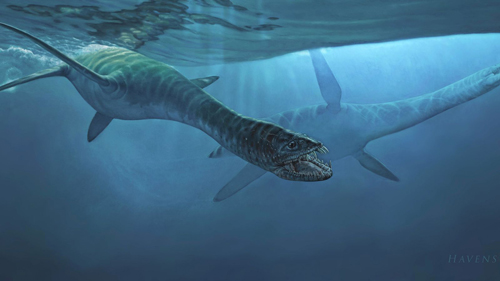Elk Hunter Stumbles Across Rare Elasmosaurid
Nakonanectes bradti – Shortest Neck and Youngest Elasmosaur from the Western Interior Seaway
A new genus of elasmosaurid has been added to the list of marine reptiles associated with the Western Interior Seaway. Named Nakonanectes bradti, this fish-eating monster lived around 70 million-years ago. A paper detailing the discovery has been published this week in the “Journal of Vertebrate Palaeontology”, Nakonanectes is the youngest elasmosaurid, stratigraphically speaking from the Western Interior Seaway, it also had a very short neck, short at least, when compared to other Late Cretaceous elasmosaurids.
To view models and replicas of elasmosaurids and other marine reptiles: CollectA Deluxe Prehistoric Life Models.
A New Genus of Short-Necked Elasmosaurid from Montana
Picture credit: James Havens
Marine Reptile Discovered by an Elk Hunter
David Bradt in 2010, stumbled across fossils of the marine reptile whilst out hunting for elk in Montana’s Charles M. Russell National Wildlife Refuge. He noticed a series of articulated bones in a stream bed and thinking that the fossils might represent a dinosaur, David alerted the authorities. When a field team visited the remote site, they followed the trail of bone fragments uphill and discovered more fossils including the remains of an exquisitely preserved skull. The Late Cretaceous reptile has been named after the native Nakona people of Montana and the trivial name honours David Bradt.
Field Team Members Working at the Excavation Site
Picture credit: Erin Clark/Associated Press
One of the authors of the scientific paper, Pat Druckenmiller (University of Alaska Museum of the North), commented:
“This group [elasmosaurids] is famous for having ridiculously long necks, I mean necks that have as many as seventy-six vertebrae [Albertonectes]. What absolutely shocked us when we dug it out, it only had somewhere around forty vertebrae.”
Nakonanectes bradti Compared to Albertonectes vanderveldei
The Bearpaw Shale Formation has provided scientists with a number of intriguing Cretaceous vertebrate fossils, including Albertonectes (A. vanderveldei). It is regarded as the longest plesiosaur known (estimated to have been more than twelve metres long). Albertonectes also has the longest neck of any Plesiosaur described to date. The neck is estimated to have been around seven metres long. The single specimen (holotype) of Albertonectes comes from the Bearpaw Shale Formation, however, these fossils were found in Alberta (near Lethbridge) and as such, come from exposures some two hundred miles north-west of the stream bed in Montana where the remains of Nakonanectes were found.
Nakonanectes bradti is believed to have had around 39-42 neck bones (cervical vertebrate). In comparison, Albertonectes had a body length twice as long and its neck was two-and-a-half times the length of N. bradti.
Comparing the Size of Nakonanectes to Albertonectes
Picture credit: Everything Dinosaur
Studying Nakonanectes
The palaeontologists conclude that the neck of Nakonanectes was about 2.3 metres long. It is difficult to accurately date the strata that makes up the Bearpaw Shale Formation. These two very different elasmosaurids may not have co-existed, but the discovery of Nakonanectes indicates that there was considerable variety in the neck length of members of the Elasmosauridae. It also suggests that as the Cretaceous period progressed so at least one lineage of elasmosaurs evolved shorter necks.
The scientific paper: “A New Elasmosaurid (Sauropterygia, Plesiosauria) from the Bearpaw Shale (Late Cretaceous, Maastrichtian) of Montana Demonstrates Multiple Evolutionary Reductions of Neck Length within Elasmosauridae”, by Serratos, D. J., P. Druckenmiller, and R. B. J. Benson published in the Journal of Vertebrate Palaeontology.
Visit Everything Dinosaur’s website: Everything Dinosaur.




